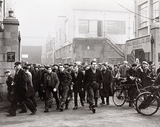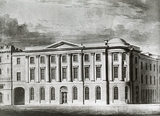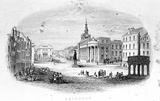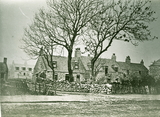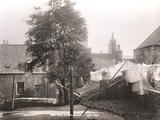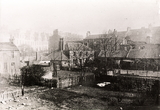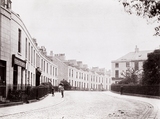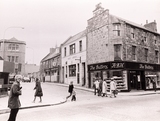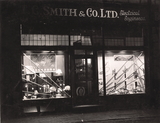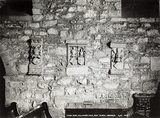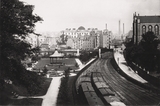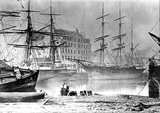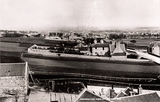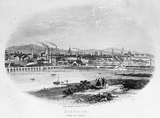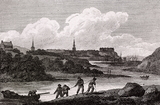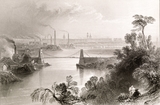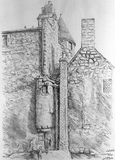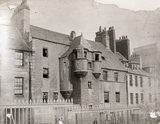|
Quick Search
|
Search Results
You searched for: More Like: 'The General Post Office'
1185 items
items as
Hall Russell shipbuilders
6 Hall Russell, Ship Builders, Marine Place c. 1950s/60s. Note the main office is off to the right. The entrance at the top of the stairs is to the loft, where scale drawing and templates were drafted. The shipwrights department was on the ground floor to the south of this building.
[Many thanks to Stanley Bruce for providing us with correct details on the building layout.] North of Scotland Bank, Aberdeen
7 In 1838, the North of Scotland Bank purchased the New Inn and other properties at the corner of Castle Street and King Street. The architect Archibald Simpson was invited to submit plans for the Bank's Head Office on the cleared site. This is a photograph of one of his designs which was not accepted. It shows a building with a curved corner topped with a dome and Corinthian columns running through the first and second floors supporting a pediment over an elaborate cornice. The plan which was adopted also had three storeys but the entrance was a Corinthian portico at the corner topped with an open platform with a terracotta sculpture group by James Giles, representing Ceres, goddess of plenty. Schoolhill
13 Old houses skirting St. Nicholas churchyard once formed part of the south side of Schoolhill. They were demolished in 1884-85 as part of a street widening scheme and the present wall and railing stand in their place. On the other side of Schoolhill (centre) can be seen the roof and turrets of George Jamesone's House, demolished in 1886.
The book Aberdeen in Byegone Days: Views of Streets and Buildings, etc. with Letterpress Description (1910) by Robert Anderson (page 26) suggests that the building in the centre of this image was the home of Burnett Carr, the grave-digger and assistant to the sexton of St. Nicholas Church.
Newspaper references indicate that Carr, a well known figure, died on 31st May 1844 (Aberdeen Journal, 5th June 1844, page 3, column 2).
This photograph looks north and shows the back of Carr's old house. The Castlegate
16 Engraving of the Castlegate, c. 1850. The statue of the last Duke of Gordon, erected in 1844, was removed in the 1950s to Golden Square. Published by G. Shepherd, Broad Street, Aberdeen Broad Street looking South
19 Busy scene in Broad Street in 1833, showing buildings on the left hand side which were demolished for the extension and frontage of Marischal College. The archway at the left led through to the original buildings of Marischal College and the original Greyfriars Church. The Water House, surmounted with a pediment and clock, was erected in 1766 as a reservoir for the town's water supply. The clock and its bell were transferred to the City Hospital in 1899. Byron lived with his mother in the tenement block next to the turreted building. On the west side of the street, the tall building in the distance was the first office of the North of Scotland Bank. Cottages with drystane dyke
22 Stoneyton, old Skene Road, approximately 300 yards west of Albert Street. Demolished 1875-76 to build part of Carden Place. The houses depicted in the above picture are listed in the Post Office Directory of 1873/74. The thatched building on the left was used as a blacksmiths shop and the other buildings were inhabited mostly by Rubislaw Quarry workers. They were demolished to make room for the erection of modern villas about 1879. Dee Village
26 Dee Village (also known as Potter's Creek), on site later covered by the Corporation Electricity Works, Millburn Street. Crown Street
27 Crown Street. The view of Crown Street changed when the block of three houses seen on the right was demolished to make way for the construction of the new General Post Office opened in April 1907. The shop seen on the left was Alexander Maver who was a tailor specialising in military uniforms. Image c.1897 Loch Street
28 Loch Street in the 1980s. Far left, corner of the new Co-op building (1970); left background, St. Paul's Street School (then Aberdeen Education Authority's Music Centre); centre, the Swan Bar, Post Office, The Buttery (A. B. Hutchison). All demolished for the Bon Accord Centre. T. C. Smith and Co., Electrical Engineers
43 Shop frontage of T. C. Smith and Co., Electrical Engineers
T.C. Smith & Co. first appear in the Aberdeen Directory for 1913/14 when they are listed as electrical, automobile and power engineers. They had garage space for over 200 cars and eight private lockups, and were open day and night, including Saturday.
The garage, showrooms and office were at 21-25 Bon-Accord Street; their repair and body building shops were at 20-32 Gordon Street. In 1921-22, they had other premises at 18 Bon-Accord Street, and these are shown in the photograph. The windows have a display of all sorts of electrical equipment including lamps, heaters, radios and Hoovers.
The company would appear to have gone out of business around 1943, because in 1946, Scottish Motor Tractor Co. Ltd had taken over their Bon-Accord premises. Castlegate at Christmas time
44 The junction of the Castlegate and Union Street at Christmas. Note the sunken public toilets at the right of the photograph. They were filled in prior to the pedestrianisation of the Castlegate. Collison's Aisle, St Nicholas Church
46 This George Washington Wilson photograph shows the memorial stones inserted in the west wall of Collison's Aisle. Originally called Aisle of the Holy Blood, it formed part of the north transept between the East and West Churches of St. Nicholas and was renamed after 1594, although it probably dates from the 14th century. Members of the Collison family held important civic offices at various times, including Provost in 1521 and 1594, and their place of burial was in this aisle. The memorial stones commemerate Andrew Cullen, Thomas Menzies and his wife Mariene Reid, and Sir John Rutherford. Andrew Cullen was a merchant and Provost of Aberdeen in 1506 and 1535, and the stone shows a sculptered coat of arms above the words "Andrew Cullen Prepositus Abd". Thomas Menzies was Provost in 1525 and (for 40 of the next 50 years), only leaving office in favour of other members of his family. He married Mariane Reid of Pitfodels. The stone has two panels above a shield bearing the Menzies coat of arms, flanked by the initials T.M. The second panel has the initials M.R. and a shield with the Menzies and Reid coats of arms. Beneath is the motto 'Spero in Deo et ipse faciet' - Trust in God and he will perform'. The third stone commemorates Sir John Rutherford of Tarland, first elected Provost of Aberdeen in 1483 and every alternate year until 1492, and again between 1496-1500. He probably died about 1520. Denburn Valley
48 The Denburn Valley Railway, shown here on the right, was constructed in 1865-67. It runs from the Joint Station at Guild Street north through the valley. To the left of the railway lines is Union Terrace Gardens which were opened to the public on 11th August 1879.
The closeness of the railway led to the gardens being nicknamed the "Trainie Park". The bandstand shown here in the centre of the park was removed in around 1931.
The iron footbridge visible in this image allowed access over the Denburn and railway between Rosemount and the city centre. It was replaced by the Denburn Viaduct which was built in 1886, at the same time as Rosemount Viaduct, by engineer William Boulton. Part of the footbridge was moved and reassembled in the newly created Duthie Park.
This image also predates the construction of significant buildings on Rosemount Viaduct such as the Public Library and the Free South Church (both dating from 1892). In the background, on the left of the image can be seen the houses at the foot of a then longer Skene Terrace. These are on the site later occupied by the library and church.
To the right of those houses are Black's Buildings. Local historian Diane Morgan explains that they were "a small curving crescent of tall tenements, four and five storeys high, [and] sat below the Royal Infirmary, Woolmanhill, just west of the apex of the Woolmanhill triangle. (...) The houses were built in stages between 1789 and 1830, by the wine merchant James Black." (Lost Aberdeen: Aberdeen's lost architectural heritage, 2004). The tenements were pulled down in 1957.
Woolmanhill Hospital, designed by Archibald Simpson and built 1832-1838, can be seen in the background. Chimneys of Broadford Works, the textile factory located between Ann Street, Maberly Street and Hutcheon Street, are also visible. Upper Dock
52 A photograph showing many large sailing ships in the Upper Dock of Aberdeen Harbour. This image looks north west towards the junction of Market and Guild Street from Regent Road (near the start of Blaikie's Quay).
The prominent granite building in the background was at the corner of this junction at 62-68 Market Street. It was a warehouse and offices with shops on the ground floor. The site was redeveloped for the office blocks that can be seen today in around the early 1980s. This block may have been demolished at that time.
Prior to the late 19th century continuing development of Market Street and the creation of Provost Jamieson's Quay, the south side of the Upper Dock was the site of various ship building yards, with timber yards behind.
The ship shown in front of the building is the City of Aberdeen. It was built in 1862 by John Duthie, Sons & Co. for the China trade. It was altered to barque rigging in 1877 and this be the period of this photograph. The ship has an entry on the Aberdeen Built Ships website here. View of Aberdeen from Torry
57 View of the city from Torry, 1850, showing the railway viaduct and the city skyline. Drawn and engraved by W. Banks and Son, Edinburgh The Wellington Suspension Bridge
67 The Wellington Suspension Bridge over the River Dee was built in 1829 by Samuel Brown and John Smith. It connects Ferryhill with the high bank of Craiglug to the south. Print dated 1850. The bridge, locally known as the 'Chain Bridge', was closed to traffic and pedestrians because of its poor condition before reopening after restoration in 2008. View of Old Aberdeen
70 Print of Old Aberdeen drawn by John Slezer. General view with the Crown Tower of King's College and the spires of St. Machar's Cathedral in the distance. The small building in the right foreground was the Snow Church - St. Mary ad Nives - which was demolished in the 1600's, although part of the burial ground survives. Old Aberdeen
71 A reproduced engraving showing the skyline of Old Aberdeen. The image looks north from around the lands of Sunnyside Farm.
In the foreground can be seen two agricultural labourers. On the skyline, going left to right, is the circular Powis Hermitage, on a hill, with its small spire, the twin spires of St. Machar Cathedral in the far distance, the tower of the Old Town House at the end of the High Street, which is protruding above the southern elevation of St. Mary's United Free Church.
Moving back along the High Street, the south facing front elevation, with bow windows, of Powis Lodge can be seen above the line of trees. The crown tower of King's College is across the street. The two minarets of the Powis Gateway are just next to it. Further along are the crenelations of Cromwell's Tower.
The tower on the far left of the image may be Dunbar's Tower.
The minaret gateway was finished in 1834 and this image likely dates from around that period. Cumberland House
76 North wall of Cumberland House (now known as Provost Skene's House). Drawing by Davidson, 1950 Lochhead Hydropathic
91 Lochhead was a mansion situated near Westburn Park. It was said to be the first hydropathic establishment in Scotland and featured Turkish and Medicated Baths. By the 1890s the building was occupied by the George Washington Wilson optical lantern slide export department. The building was demolished in 1932, and the grounds became part of Westburn Park. George Jamesone's House
93 George Jamesone's House in Schoolhill. This house was generally believed to be the residence as well as the property of George Jamesone, the painter, known as the Scottish Van Dyck. By the 1880s it had become a lodging house, and was demolished in 1886. The site is now marked by a plaque on the buildings which replaced it. |



